Reign 19 June 2014 – present Prime Minister Mariano Rajoy Enthronement 19 June 2014 Name Felipe of | Predecessor Juan Carlos I Role King of Spain Heir presumptive Leonor Height 1.97 m | |
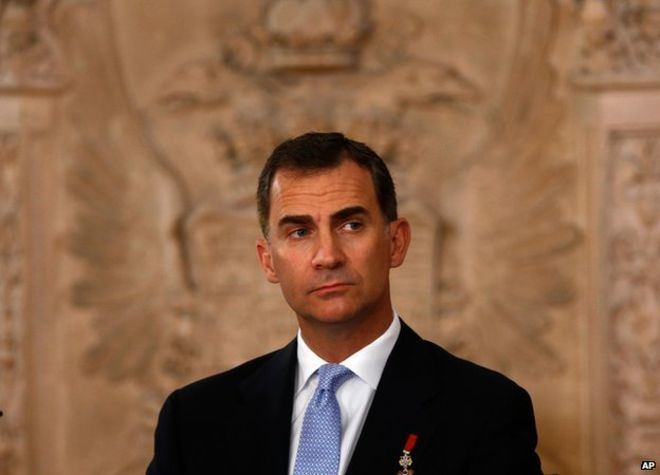 | ||
Born 30 January 1968 (age 57)
Madrid, Spain ( 1968-01-30 ) Issue Leonor, Princess of Asturias
Infanta Sofia Spouse Letizia of Spain (m. 2004) Children Leonor, Princess of Asturias, Infanta Sofia of Spain Parents Juan Carlos I of Spain, Sofia of Spain Siblings Cristina Federica, Infanta of Spain, Infanta Elena, Duchess of Lugo Similar People Letizia of Spain, Juan Carlos I of Spain, Leonor - Princess of Asturias, Sofia of Spain, Cristina Federica - Infanta of | ||
King felipe vi of spain visits bertelsmann
Felipe VI ([feˈlipe]; Felipe Juan Pablo Alfonso de Todos los Santos de Borbón y Grecia; born 30 January 1968) is the King of Spain. He ascended to the throne on 19 June 2014 following the abdication of his father, King Juan Carlos I. He is the only son of Juan Carlos and his wife Sofía of Greece and Denmark. When Juan Carlos was chosen in 1969 to be Francisco Franco's successor, Felipe became second in line to the Spanish throne.
Contents
- King felipe vi of spain visits bertelsmann
- Prince harry hosts king felipe vi of spain at westminster abbey
- Birth and early life
- Education and military training
- Activities in Spain and abroad
- Social activities
- Sports and participation in the Olympics
- Reign
- Marriage and issue
- Titles and styles
- Arms
- References
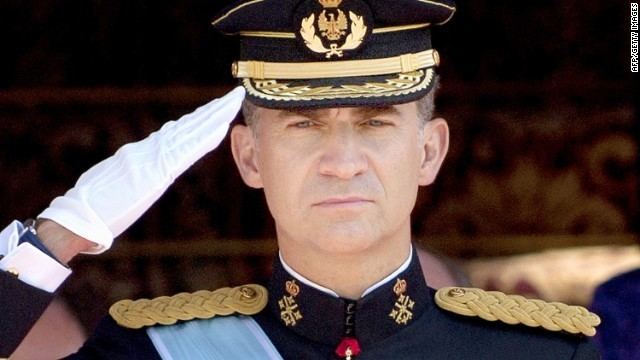
In 2004, Felipe married TV news journalist Letizia Ortiz with whom he has two daughters. Leonor, the elder, is his heir presumptive. In accordance with the Spanish Constitution, as monarch, he is head of state and commander-in-chief of the Spanish Armed Forces, and also plays a role in promoting relations with Hispanic America and the former Spanish East Indies, which are collectively called the "nations of its historical community".

Prince harry hosts king felipe vi of spain at westminster abbey
Birth and early life
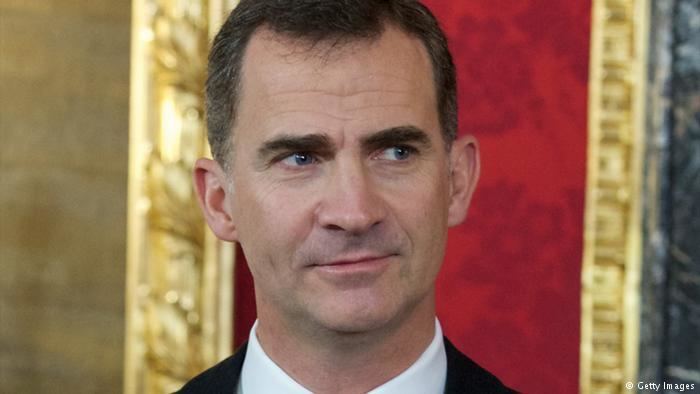
Felipe was born at Our Lady of Loreto Clinic in Madrid, the third child and only son of Infante Juan Carlos of Spain and Princess Sofía of Greece and Denmark. He was baptised on 8 February 1968 at the Palace of Zarzuela by the Archbishop of Madrid, Casimiro Morcillo. His full baptismal name, Felipe Juan Pablo Alfonso de Todos los Santos, consists of the names of the first Bourbon King of Spain (Philip V), his grandfathers (Infante Juan of Spain and King Paul of Greece), his great-grandfather King Alfonso XIII of Spain, and de Todos los Santos as is customary among the Bourbons. His godparents were his paternal grandfather Juan and his paternal great-grandmother, Queen Victoria Eugenie of Spain.
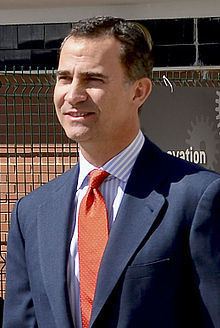
Shortly after his birth he was styled infante, although his father was not yet king. The ruling dictator Generalissimo Francisco Franco died just over two months before Felipe's eighth birthday, and Felipe's father ascended the throne. In his first official appearance, Felipe attended his father's proclamation as king on 22 November 1975.
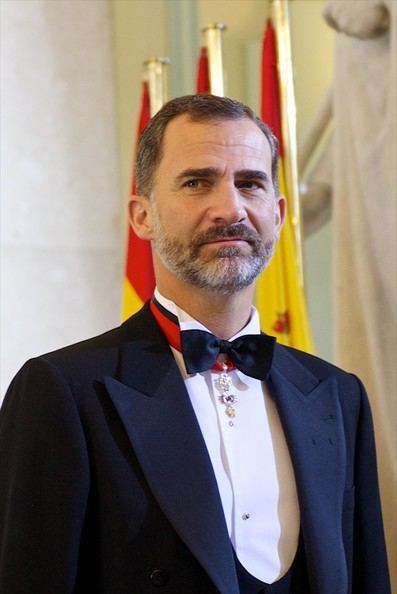
In 1977, Felipe was formally created Prince of Asturias. In May, nine-year-old Felipe was made an honorary soldier of the 1st King's Immemorial Infantry Regiment. The occasion was marked on 28 May and was attended by the king, the prime minister and several other ministers in a ceremony at the infantry's barracks. On 1 November the same year, he was ceremoniously paid homage as Prince of Asturias in Covadonga. In 1981 Felipe received the Collar of the Order of the Golden Fleece from his father, the Chief and Sovereign of the Order. On his 18th birthday on 30 January 1986, Felipe swore allegiance to the Constitution and to the King in the Spanish Parliament as required by the constitution, fully accepting his role as successor to the Crown.
Education and military training
Felipe attended school at Santa María de los Rosales, which his daughters currently attend. Felipe attended high school at Lakefield College School in Ontario, Canada, and studied at the Autonomous University of Madrid, where he graduated with a degree in Law; he also completed several courses in Economics. He completed his academic studies by obtaining a Master of Science in Foreign Service degree from the Edmund A. Walsh School of Foreign Service at Georgetown University, where he was the roommate of his cousin, Crown Prince Pavlos of Greece.
As the heir to the throne, a carefully regulated and structured plan was laid out for Felipe's military training. In August 1985, a Royal Decree named Felipe as officer at the General Military Academy in Zaragoza. He began his military training there in September. He completed the first phase of his formation in October. In July 1986, he was promoted to Cadet 2nd Lieutenant. He was also named as Midshipman. On September 1986, he began his naval training at the Escuela Naval Militar in Pontevedra, joining the Third Brigade. In January 1987, he continued his naval training on board the training ship Juan Sebastián Elcano. In July, he was named as Student Ensign at the Academia General del Aire in Murcia. In September 1987, he began his air force training there. where he learned to fly aircraft. In 1989, he was promoted to lieutenant in the Army, ensign in the Navy, and lieutenant in the Air Force. In 1992, he was promoted to captain in the Air Force. In 1993, he was promoted to lieutenant in the Navy and captain in the Infantry of the Army.
Further promotions in 2000 were commandant in the Army, corvette captain in the Navy, and commandant in the Air Force. Promotions in 2009 were lieutenant colonel in the Army, frigate captain in the Navy, and lieutenant colonel in the Air Force.
Since June 19, 2014, after his ascension to the throne, he acquired the rank of Capitán General (Commander-in-chief) of all the Spanish armies (Land, Navy and Air Force).
Activities in Spain and abroad
Felipe undertook his constitutional duties assiduously as heir to the throne, hosting many official events in Spain and participating in all events of different sectors and aspects of Spanish public life as required. Since October 1995, Felipe has represented Spain on a series of official visits to the Spanish Autonomous Communities, starting with Valencia, during which he made contact with Spaniards from all walks of life. Felipe has held regular meetings with constitutional bodies and state institutions keeping up-to-date with their activities. He also attends meetings of the various bodies of the Central Administration and of the Autonomous Communities as required by his national and international constitutional obligations. Felipe has welcomed as many public and private audiences as possible to maintain Crown interaction in national and international affairs. In particular, he has held meetings with people of his generation who have built successful careers in political, economic, cultural and media circles. As part of his military training, Felipe trained as a military helicopter pilot. On occasions when King Juan Carlos was unable to attend, Felipe presided over the annual presentation of dispatches to officers and non-commissioned officers in the Armed Forces as well as participating in military exercises held by the three Armed Services.
Felipe has made many official visits to Europe and Latin America, as well as to countries in the Arab World, the Far East, and Australia, maintaining a special interest in all matters relating to the European Union, Latin America, the Middle East and North Africa. Since January 1996, Felipe has represented the Spanish State at many Latin American presidents' inauguration ceremonies. As Prince, he visited every country in Latin America except Cuba, and made over 200 foreign trips in total. Felipe has also played a very active role in promoting Spain's economic, commercial and cultural interests and the Spanish language abroad. He frequently represents Spain at world economic and trade events (e.g. Expotecnia, Expoconsumo, and Expohabitat), and is especially interested in promoting the creation of Centres and University Chairs to advance the study of Spain both historically and in the present-day at major foreign universities.
Following the 11 March 2004 Madrid bombings, Felipe, along with his sisters Elena and Cristina, took part in a public demonstration.
Felipe speaks Spanish, Catalan, French, English and some Greek.
Social activities
In addition to his official activities, Felipe serves as Honorary President of several associations and foundations, such as the Codespa Foundation, which finances economic and social development in Ibero-America and other countries, and the Spanish branch of the Association of European Journalists, comprising outstanding communications professionals. Most noteworthy is the Príncipe de Asturias Foundation, where he presides annually at the international awards ceremony of the highly prestigious Prince of Asturias Awards bearing his name.
Felipe was appointed a "UN-Eminent Person" by UN Secretary General Kofi Annan in 2001, during its International Year of Volunteers, and continues to make contributions internationally towards enhancing the importance of voluntary work.
Sports and participation in the Olympics
Felipe was a member of the Spanish Olympic sailing team at the Barcelona Games in 1992. Felipe took part in the opening ceremony as the Spanish team's flag bearer. The Spanish crew finished in sixth place in the Soling class and obtained an Olympic diploma.
Felipe has been a supporter of Atlético Madrid since watching them win the 1976 Copa del Generalísimo Final.
Felipe, himself 197 cm (6 ft 5 1⁄2 in) in height, has attended Spanish, European, and Olympic basketball championships.
Both his mother and uncle were on the Greek sailing team at the 1960 Summer Olympics in Rome (his mother as a substitute), and Felipe's father and sister were also Olympic sailors for Spain.
Reign
On 2 June 2014, King Juan Carlos announced his intent to abdicate in Felipe's favour. As required by the Constitution of Spain, the Spanish Cabinet began deliberations the following day on an organic law to give effect to the abdication. The law had to be passed by a majority of all members of the Congress of Deputies, the lower house of the Cortes Generales (Parliament). According to Jesús Posada, the President of the Congress of Deputies, Felipe could have been proclaimed king as early as 18 June. On 4 June, El País of Madrid reported that Felipe would indeed be proclaimed king on 18 June.
Felipe ascended the throne at the stroke of midnight on 19 June; his father had given his sanction to the organic law effecting his abdication just hours earlier. The next morning, after receiving the captain general's sash from his father, he was formally sworn-in and proclaimed king in a low-key ceremony held in the Cortes. He swore to uphold the Constitution before formally being proclaimed king by Posada. Upon his accession, he became the youngest monarch in Europe, being nine months younger than King Willem-Alexander of the Netherlands.
As king, Felipe has fairly extensive reserve powers on paper. He is the guardian of the Constitution, responsible for ensuring it is obeyed. While he is nominally chief executive, it is expected that he will follow his father's practice of taking a mostly ceremonial and representative role, acting largely on the advice of the government. He indicated as much in a speech to the Cortes on the day of his enthronement, saying that he would be "a loyal head of state who is ready to listen and understand, warn and advise as well as to defend the public interest at all times". A poll conducted by El País, however, indicates that a majority of Spaniards wish that Felipe play a greater role in politics, with 75% of the 600 surveyed people stating that they would approve if he personally pushed the political parties to reach agreements on national problems. According to an El Mundo newspaper poll, Felipe had a greater approval than his father prior to his reign.
In June 2014, Felipe and Letizia became the first Spanish monarch and consort to receive and recognize LGBT organisations at the Palace. Felipe also changed the protocol in order to allow people to take the oath of office without a crucifix or Bible. In their first overseas trip as monarchs, Felipe VI and Queen Letizia met Pope Francis on 30 June 2014, in the Apostolic Palace. They subsequently met with Cardinal Secretary of State Pietro Parolin, accompanied by Mgsr. Antoine Camilleri, under-secretary for Relations with States. The visit followed one by King Juan Carlos I and Queen Sofía on 28 April. On 18 July, he first attended a meeting of the Council of Ministers.
In February 2015, Felipe announced that he would cut his annual salary by 20% as a result of the economic recession and hardships continuing to hamper Spain.
The elections in 2015 resulted in no party winning enough seats to form a government. No agreements with the different parties were successful. After months of talks with the different party leaders, and with there being no apparent candidate in a position of support in forming a government, a royal decree was issued dissolving parliament with new elections being called in June. This marked the first time since the transition to democracy that an election was called under Article 99.5 of the Constitution, wherein the initiative for issuing the dissolution of the Cortes belonged to the King and not to the Prime Minister.
Marriage and issue
Felipe's bachelor years were a source of interest to the Spanish press for several years. His name was linked with several eligible women, but only two notable girlfriends: Spanish noblewoman Isabel Sartorius, around 1989 to 1991, daughter of Vicente Sartorius y Cabeza de Vaca, who was viewed unfavourably by the Royal Family due to her mother's cocaine addiction, and Norwegian model Eva Sannum, who modelled underwear. When Felipe finally began a serious relationship, nothing was suspected before the official announcement of the Prince's engagement on 1 November 2003 to Letizia Ortiz Rocasolano, an award-winning television journalist formerly with CNN who had been married previously. The couple were married on the morning of 22 May 2004 in the Almudena Cathedral, Madrid, with representatives of royal families from all over the world and most heads of state from Latin America present.
Felipe and Letizia have two daughters: Leonor, Princess of Asturias, born on 31 October 2005, and Infanta Sofía, born on 29 April 2007.
Titles and styles
Though Juan Carlos held no official title or post in Spain prior to 1969, his son Felipe was registered in the Civil Registry as an 'Infante' when he was born, with the style of Royal Highness. About a year later, General Franco recognised Juan Carlos as the future successor to the headship of state and bestowed upon him the title of Prince of Spain. Thus, Felipe became second-in-line in the line of succession to the vacant throne.
Juan Carlos became king in 1975, but no title was conferred on Felipe as heir apparent until 1977, when he was created Prince of Asturias, the traditional title normally held by the heir to the Spanish throne. The royal decree granting him this title also entitled him to use "the other historical titles corresponding to the heir of the Crown". Felipe started using the Aragonese-Catalan title of Prince of Girona publicly on 21 April 1990, during a trip around Aragon, Catalonia and Valencia, becoming the first Bourbon to use this title. Later, he did the same thing with the Princedom of Viana in Navarre, and the titles of Duke of Montblanc, Count of Cervera and Lord of Balaguer in their respective places.
Upon ascending the throne, Felipe assumed the same titles held by his father. If the former Kingdoms of Aragon and Navarre had separate naming styles, he would also be known as Felipe V of Aragon and Felipe VII of Navarre along with Felipe VI of Castile.
Arms
As heir to the Spanish throne, Felipe's coat of arms were the Spanish arms differenced with a label of three points azure (blue). The first quarter represents Castile, the second León, the third Aragon and the fourth Navarre; below are the arms of Granada. In the centre, on an inescutcheon, is the ancestral arms of the sovereign House of Bourbon-Anjou. Surrounding the shield is the collar of the Order of the Golden Fleece and surmounting it was the heraldic crown of the heir to the throne, decorated with four half-arches.
Following his accession to the throne, the label on his arms was removed and the crown of the heir was changed to that of the monarch's (eight half-arches instead of four). This arms differ from that of his father's as king as they do not feature the Cross of Burgundy or the yoke, and sheaf of five arrows.
